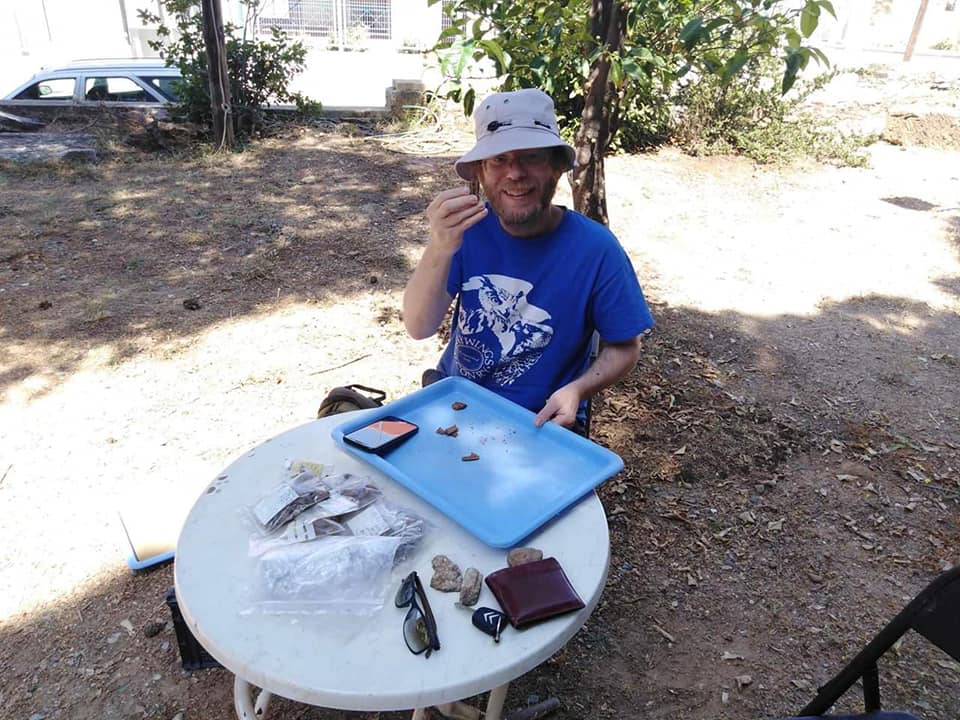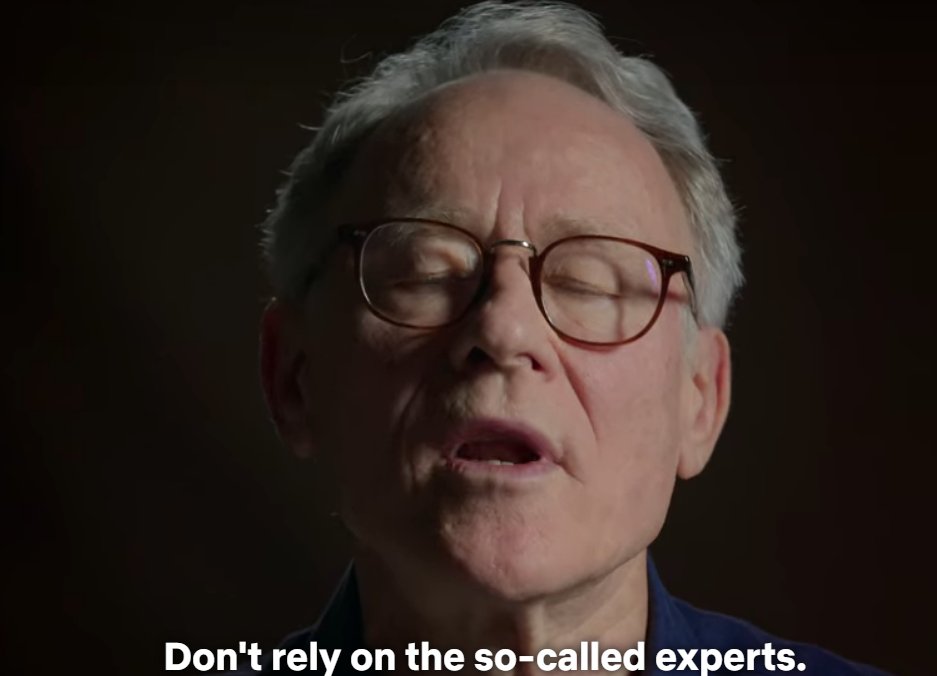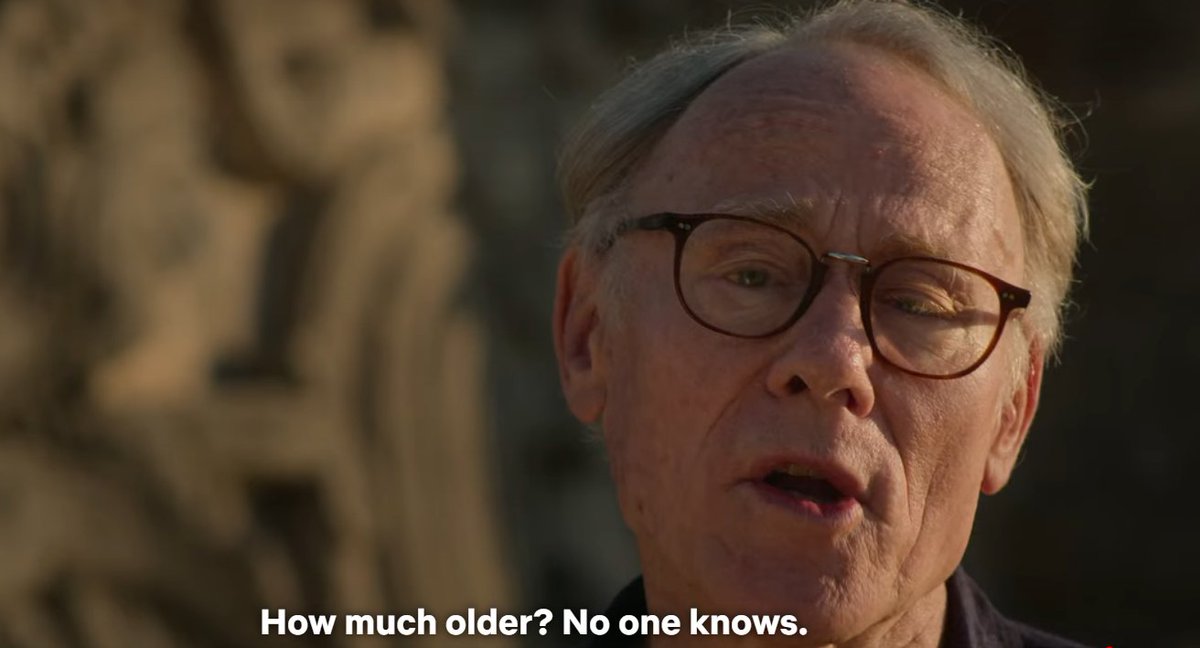
In his new Netflix “documentary” #AncientApocalypse, @Graham__Hancock has declared war on archaeologists
His rhetoric sows distrust in experts, and #Atlantis conspiracy theories promote white supremacy
Buckle up, it’s time for an #ARCHAEOLOGY THREAD 🧵
/1
His rhetoric sows distrust in experts, and #Atlantis conspiracy theories promote white supremacy
Buckle up, it’s time for an #ARCHAEOLOGY THREAD 🧵
/1

This thread will examine
1)Hancock's lack of evidence
2)How Hancock’s narrative recycles 19th century ideas on #Atlantis
3)The rhetorical tools Hancock and similar conspiracy theories use
/2
1)Hancock's lack of evidence
2)How Hancock’s narrative recycles 19th century ideas on #Atlantis
3)The rhetorical tools Hancock and similar conspiracy theories use
/2
Why trust me?
No idea. I’m just a dude who won’t pay for a checkmark
But I am a real archaeologist. I’ve excavated at sites spanning tens of thousands of years of human history & prehistory
Trust my credentials or don’t. But I’ll present real evidence why this show is crap
/3
No idea. I’m just a dude who won’t pay for a checkmark
But I am a real archaeologist. I’ve excavated at sites spanning tens of thousands of years of human history & prehistory
Trust my credentials or don’t. But I’ll present real evidence why this show is crap
/3

The first lines of Ancient Apocalypse define Hancock’s all out assault upon real #archaeology
And he doesn’t stop sneering. It is total war against “mainstream” archaeologists, “so-called experts,” who are “defensive, arrogant, and patronizing,” & “utterly confounded”
/4

And he doesn’t stop sneering. It is total war against “mainstream” archaeologists, “so-called experts,” who are “defensive, arrogant, and patronizing,” & “utterly confounded”
/4


Why is Graham__Hancock so aggressive against archaeologists?
Apparently, it’s because my colleagues have been calling him a “pseudoarchaeologist” for decades
That hurts his feelings
/5
Apparently, it’s because my colleagues have been calling him a “pseudoarchaeologist” for decades
That hurts his feelings
/5
Despite writing multiple books about archaeology and hosting a show on Netflix that is labeled a “docuseries” and covers archaeology, Graham__Hancock says he is not an archaeologist
He calls himself an “journalist” who investigates “human prehistory”
/6



He calls himself an “journalist” who investigates “human prehistory”
/6




That’s an odd claim. Journalists investigate events happening today. They interview living people. They examine documents & accounts to reveal ongoing or recent events
Prehistoric humans can’t give interviews. It wasn’t till historical times that humans left documents behind
/7
Prehistoric humans can’t give interviews. It wasn’t till historical times that humans left documents behind
/7
The real reason for Graham Hancock’s aggressive rhetoric against archaeologists & historians is because it sells. It’s attention grabbing. It starts Twitter feuds. It fits with conspiracy thinking
It’s also a sleight of hand that covers up his lack of evidence
Let’s dig in
/8

It’s also a sleight of hand that covers up his lack of evidence
Let’s dig in
/8


Hancock’s claim is there’s a MYSTERIOUS & ADVANCED Ice Age civilization that spanned the globe
This lost civilization was destroyed in an APOCALYPTIC flood. Its few survivors taught Stone Age humans the secrets of agriculture, architecture, and other advanced technologies
/9



This lost civilization was destroyed in an APOCALYPTIC flood. Its few survivors taught Stone Age humans the secrets of agriculture, architecture, and other advanced technologies
/9




Why isn’t this civilization found in textbooks?
1.It mostly vanished in the flood leaving few traces behind
2.Humans have “amnesia” and forgot about it
3.Archaeologists refuse to investigate it because it threatens their theories
/10
1.It mostly vanished in the flood leaving few traces behind
2.Humans have “amnesia” and forgot about it
3.Archaeologists refuse to investigate it because it threatens their theories
/10

I used to laugh at this kind of argument because it’s ridiculous if you know the evidence
But, more and more people believe in conspiracy theories today, whether they be QAnon types, Ancient Aliens, or #Atlantis (which Hancock thinks this Ice Age civilization is)
/11
But, more and more people believe in conspiracy theories today, whether they be QAnon types, Ancient Aliens, or #Atlantis (which Hancock thinks this Ice Age civilization is)
/11

If you look closely, Hancock doesn’t ever present any real evidence. Just a range of negative evidence: endless possibilities and suppositions, untested claims, and many explanations for why there isn’t evidence
We can walk through a few examples
/12
We can walk through a few examples
/12
In the final episode, Hancock & Randall Carlson suggest the flood that ended this worldwide Ice Age civilization was caused by a comet impact that melted the glaciers
Why is there no crater? Because it landed in a glacier, proving the flooding and missing evidence
/13


Why is there no crater? Because it landed in a glacier, proving the flooding and missing evidence
/13



One of Hancock’s favorite type of evidence comes from remote sensing. Tools like metal detecting or ground penetrating radar (GPR) that help archaeologists get a sense of what is underground or not visible
But these tools are not foolproof and need “groundtruthing”
/14
But these tools are not foolproof and need “groundtruthing”
/14
Think about it like this. You have a metal detector and decide to do some remote sensing. You walk across a field and pick up some magnetic signals
Do you automatically conclude that it’s a hoard of treasure?
/15
Do you automatically conclude that it’s a hoard of treasure?
/15

Same thing with ground penetrating radar. It pulses radar underground and measures the reflected signal
There can be lots of explanations for a reflected signal, and so archaeologists always “groundtruth” their results by excavating a sample
/16
There can be lots of explanations for a reflected signal, and so archaeologists always “groundtruth” their results by excavating a sample
/16
You can read the thread below about groundtruthing our GPR survey at #Histria in Romania. While the hotspot was a kiln, what the GPR missed were the many graves (including a monumental one)
It was half right/half wrong and needed groundtruthing
/17
It was half right/half wrong and needed groundtruthing
/17
https://twitter.com/FlintDibble/status/1116012524762275840
In Hancock’s presentation of GPR evidence, none have been groundtruthed. No voids at Gunung Padang etc
He’s basically picked up a confusing signal on a metal detector and made a multi-million dollar Netflix show about how it must be Smaug’s treasure from the Hobbit
/18
He’s basically picked up a confusing signal on a metal detector and made a multi-million dollar Netflix show about how it must be Smaug’s treasure from the Hobbit
/18

If you’re wondering why these sites haven’t been excavated, they have!
Hancock makes claims about some of the most famous archaeological sites in the world
Every single site he highlights has been intensively investigated. Archaeologists know a lot about them
/19
Hancock makes claims about some of the most famous archaeological sites in the world
Every single site he highlights has been intensively investigated. Archaeologists know a lot about them
/19
The most important argument that Hancock needs to prove to be right is that all these famous monuments like Cholula or Poverty Point or Ggigantija date to the Ice Age
He presents a wide variety of arguments based on negative evidence for why he must be right
/20
He presents a wide variety of arguments based on negative evidence for why he must be right
/20

One of his most common arguments is archaeologists themselves have found new evidence showing occupation at some of these sites is older than previously thought
But in no case does this evidence match his argument. They almost all date thousands of years after the Ice Age
/21
But in no case does this evidence match his argument. They almost all date thousands of years after the Ice Age
/21
Hancock argues that archaeologists want to censor his argument. But then why are they publishing new dates for sites when they find them? That’s how we make a scholarly name for ourselves. We come to a new conclusion and argue it with evidence
/22
/22

In one hilarious example, at Derinkuyu, Hancock accuses archaeologists of hiding their new dates. They publish them, but the signs on the site haven’t been changed yet. So, it’s all a conspiracy of us hiding our research!
/23
/23

In fact, archaeologists know a whole lot about Ice Age archaeology around the world.
Thousands of sites have been excavated, none of which he mentions. We have published typologies of artifacts. Thousands upon thousands of pages of words, drawings, and photographs
/24

Thousands of sites have been excavated, none of which he mentions. We have published typologies of artifacts. Thousands upon thousands of pages of words, drawings, and photographs
/24


Graham Hancock argues this advanced civilization lived alongside the hunter-gatherers who have left behind abundant evidence
Millions of stone tools and bones. Beautiful sculptures and paintings. Evidence for families, migrations, and feasts. Real evidence for real people
/25



Millions of stone tools and bones. Beautiful sculptures and paintings. Evidence for families, migrations, and feasts. Real evidence for real people
/25




How is it that despite so much research, we haven’t found Hancock’s global, advanced, Ice Age civilization?
Look around you. Look at the streets, cars, skyscrapers, bottles, and cans. We’re a global, advanced civilization and there’s no way future archaeologists will miss us
/26
Look around you. Look at the streets, cars, skyscrapers, bottles, and cans. We’re a global, advanced civilization and there’s no way future archaeologists will miss us
/26

Again. Hancock’s argument is based on “negative evidence.”
His “flood” has wiped out the evidence for a lost, advanced civilization, but somehow not all the abundant evidence for actual people who lived at the time
I’m convinced, aren’t you?
/27
His “flood” has wiped out the evidence for a lost, advanced civilization, but somehow not all the abundant evidence for actual people who lived at the time
I’m convinced, aren’t you?
/27
But an important take away point here, is that Hancock is presenting this theory of an advanced, global, Ice Age civilization as if it’s based off of his own independent research
It’s not. This theory has been around hundreds of years. It’s been disproven repeatedly
/28
It’s not. This theory has been around hundreds of years. It’s been disproven repeatedly
/28
Hancock openly admits that his theories directly relate to the story of #Atlantis first told by Plato
If you’re interested in Plato’s philosophical allegory of Atlantis and how it relates to #archaeology, check out my earlier thread:
/29
If you’re interested in Plato’s philosophical allegory of Atlantis and how it relates to #archaeology, check out my earlier thread:
https://twitter.com/FlintDibble/status/1393689542914359297
/29
But this idea of an advanced, global civilization from before the flood doesn’t come from Plato’s #Atlantis
It comes from a half-finished fictional novel by Francis Bacon: The New Atlantis
/30 (thread continues, click “show replies”)
It comes from a half-finished fictional novel by Francis Bacon: The New Atlantis
/30 (thread continues, click “show replies”)

Plato’s #Atlantis is just another Greek-style city-state. Powerful for sure, but defeated by Athens, not some super civilization, no advanced survivors to teach humans
However, Bacon’s Atlantis is a civilization that is advanced, global, and stays hidden after the flood
/31
However, Bacon’s Atlantis is a civilization that is advanced, global, and stays hidden after the flood
/31
In Bacon’s story, Renaissance explorers visit New Bensalem an island in the Pacific inhabited by the survivors of the flood from this advanced civilization
These people are Christians and advanced technologically. They’ve been watching and guiding the world
/32
These people are Christians and advanced technologically. They’ve been watching and guiding the world
/32

But Bacon wrote fiction. Hancock isn’t getting his ideas from him
No, he’s parroting the first and most popular pseudoarchaeology book ever written
Atlantis: The Antediluvian World published in 1882 by Ignatius Donnelly
/33
No, he’s parroting the first and most popular pseudoarchaeology book ever written
Atlantis: The Antediluvian World published in 1882 by Ignatius Donnelly
/33

Ignatius Donnelly parroted Bacon and about 100 other scholars, philosophers, theologians, and quacks
He brings together everything: real archaeology and fake facts, combined with some wild assumptions to craft a universal narrative that explains all of history
/34
He brings together everything: real archaeology and fake facts, combined with some wild assumptions to craft a universal narrative that explains all of history
/34

That’s one of the tells for pseudoarchaeology vs. real archaeology. Any narrative that claims there’s a single key or hidden pattern that explains all of human history is not real archaeology
Human history and prehistory is complicated. Just look at our own world
/35
Human history and prehistory is complicated. Just look at our own world
/35
Both Donnelly and Hancock claim
A cataclysm destroyed an advanced, global civilization
Survivors of this #Atlantis were responsible for agriculture, pyramids (and other monuments), and advanced technology
Myths about gods and heroes were recollections these survivors
/36


A cataclysm destroyed an advanced, global civilization
Survivors of this #Atlantis were responsible for agriculture, pyramids (and other monuments), and advanced technology
Myths about gods and heroes were recollections these survivors
/36



You might be saying. C’mon. Donnelly wrote this in 1882. Surely, it couldn’t be a direct influence on Graham Hancock
WRONG
It’s easy to prove the direct influence from Donnelly to Hancock since there are several citations to Donnelly in his books
/37
WRONG
It’s easy to prove the direct influence from Donnelly to Hancock since there are several citations to Donnelly in his books
/37

But Hancock would fail my class. He never credits Donnelly for the larger narrative, only smaller details
Take Quetzalcoatl, which Hancock introduces as the key story of a survivor from Atlantis teaching civilization to the survivors of the cataclysm. A foreign, bearded man
/38
Take Quetzalcoatl, which Hancock introduces as the key story of a survivor from Atlantis teaching civilization to the survivors of the cataclysm. A foreign, bearded man
/38

This description is directly lifted from Donnelly who describes Quetzalcoatl below as a “white man” with a “beard” who taught many arts to the Mexicans
And in Magicians of the Gods, Hancock describes him as “white,” citing Donnelly
/39

And in Magicians of the Gods, Hancock describes him as “white,” citing Donnelly
/39


(CW: racism)
Ignatius Donnelly’s hypotheses from 1882 about Atlantis are filled with white supremacy
He was obsessed with skin color (it is brought up dozens of times), and while his facts are wrong, his racism is clear
/40



Ignatius Donnelly’s hypotheses from 1882 about Atlantis are filled with white supremacy
He was obsessed with skin color (it is brought up dozens of times), and while his facts are wrong, his racism is clear
/40




Donnelly is quite obvious too in his racist contrast between “civilized” and “savage.” In his idea, any great American nations were merely “colonies of Atlantis”
Atlantis functioned to steal credit from indigenous people for their monumental heritage
/41



Atlantis functioned to steal credit from indigenous people for their monumental heritage
/41




While skin color is not in the TV series, Hancock’s books are equally filled with descriptions of white saviors
These representatives, like Quetzlcoatl or are white-skinned and bearded, and introduce “civilization” to more “simple” people
/42



These representatives, like Quetzlcoatl or are white-skinned and bearded, and introduce “civilization” to more “simple” people
/42




Pseudoarchaeology, in many of its forms, functions to steal credit from indigenous people
It couldn’t have been black and brown people who built the monuments, it was Atlantides or aliens or white people
/43
sapiens.org/archaeology/ps…
It couldn’t have been black and brown people who built the monuments, it was Atlantides or aliens or white people
/43
sapiens.org/archaeology/ps…
We live in a world filled with conspiracy theories, and this look at Hancock’s Ancient Apocalypse reveals some key clues to how to identify them
Be on the lookout for clever explanations for a lack of evidence, like an unproven comet in a glacier that leaves no crater
/44
Be on the lookout for clever explanations for a lack of evidence, like an unproven comet in a glacier that leaves no crater
/44

Conspiracy theorists will also craft definitions that suit their purposes. Hancock tries to define a pyramid as a series of terraces climbing to a summit
We know that’s not it, but it sounds clever with the right imagery
/45


We know that’s not it, but it sounds clever with the right imagery
/45



This is a ludicrous definition. Most human settlements on a somewhat steep slope are a series of terraces climbing to a summit
I’ve personally excavated at 3 such sites, like Azoria on the island of Crete below
/46
I’ve personally excavated at 3 such sites, like Azoria on the island of Crete below
/46
Conspiracy theorists also fill the void of negative evidence with circular reasoning.
Throughout Ancient Apocalypse, circular reasoning is the key manner in which Hancock fits monuments into his proposed Ice Age civilization
/47
Throughout Ancient Apocalypse, circular reasoning is the key manner in which Hancock fits monuments into his proposed Ice Age civilization
/47

As with Donnelly, conspiracy theories tend to be universal. They will put everything in a neat box. All of human history. All of today’s problems. An easy fix to the pandemic
Real knowledge is nuanced and complicated
/48
Real knowledge is nuanced and complicated
/48

Finally, conspiracy theories will craft their universal picture by ignoring context. They will make connections that really don’t make sense
Pyramids in different places don’t need to be from the same culture
/49
Pyramids in different places don’t need to be from the same culture
/49

you can click here to head to top and retweet this thread:
https://twitter.com/FlintDibble/status/1591863566273073154
I've been busy watching these episodes and collecting images/quotes all weekend to write this so I can do my real job tomorrow
I know many colleagues have shared their own takes & I've missed most, can you all please post them below for me to promote and others to find easily
I know many colleagues have shared their own takes & I've missed most, can you all please post them below for me to promote and others to find easily
Here's a thread filled with great #archaeology books
I'd also recommend a key book that @fiftysitesbook left off: Frauds, Myths, and Mysteries: Science and Pseudoscience in Archaeology by Kenneth L. Feder
I'd also recommend a key book that @fiftysitesbook left off: Frauds, Myths, and Mysteries: Science and Pseudoscience in Archaeology by Kenneth L. Feder
https://twitter.com/fiftysitesbook/status/1591831436226592768?t=HJanhQmRJAfnwmYQzgf-ag&s=19
Damn that hurt...
But more evidence to show the world the type of people who watch these documentaries. Look at the conclusions they draw
But more evidence to show the world the type of people who watch these documentaries. Look at the conclusions they draw

And yes, some parents use these fictional shows as education for their children...
Shame on @netflix for calling Ancient Apocalypse a "docuseries" and @IMDb for labeling it a "documentary"
It is pure fiction based off of no facts
Shame on @netflix for calling Ancient Apocalypse a "docuseries" and @IMDb for labeling it a "documentary"
It is pure fiction based off of no facts

Since people keep asking, I have a thread on the relationship of the Atlantis story to eugenics and racism
https://twitter.com/FlintDibble/status/1434139953815040007?t=DgxK6nEYgFdbE5gzvnUtNA&s=19
Also, why not read some real #archaeology?
https://twitter.com/FlintDibble/status/1271430158084423681?t=yudpKPOFszGfgcHseXtbXA&s=19
For a lot of people it seems Twitter hides the last chunk of the thread. Either hit "show replies" or you can find it here
https://twitter.com/FlintDibble/status/1591865082618732546?t=7_mvGdP4PDBaJBhuSPh4Ew&s=19
And a larger collection of appalling statements made by Hancock over the years (collected by @MTB_Archaeology)
https://twitter.com/MTB_Archaeology/status/1582554643984285696?t=GBuQ52e3XbFuTRArBoeMXg&s=19
I've also tooted this thread on Mastodon, so if you're on there, give it a retoot, I mean boost 😀
archaeo.social/@FlintDibble/1…
archaeo.social/@FlintDibble/1…
• • •
Missing some Tweet in this thread? You can try to
force a refresh


















